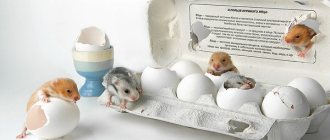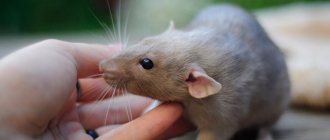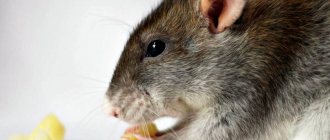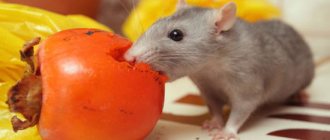What should be included in a rat's diet?
Feed and grain are the basis of nutrition
Special rat food is the basis of pet nutrition. It can not only be purchased at a pet store and from various manufacturers, but also made from grains. Store-bought food is more popular than its homemade counterpart: you don’t need to prepare it, calculate proportions, or look for ingredients. However, there are situations in which you cannot do without a grain mixture - the pet is allergic to store-bought mixtures, the composition is not “pure”, the price is inflated by the manufacturer, etc.
From cereals and grains, rodents can be fed buckwheat, millet, pearl barley, rye and rice.
Give with caution: corn, wheat and oats due to calorie content.
Semolina, as you know, is neither beneficial nor harmful, so you can find better cereals to replace it.
Vegetables and fruits as complementary foods
If your rat is prone to obesity and you are monitoring his weight gain, then vegetables, fruits and greens will not harm his figure in any way due to their low calorie content. It is also no secret that this is a source of essential vitamins, minerals and fiber.
But the absence of this complementary food can be just as dangerous as its excess - it can lead to illness, problems with the gastrointestinal tract and poor health of the animal in general. Do not forget that complementary foods cannot replace or serve as the main part of the diet.
Remember! When introducing any product (be it vegetables, fruits, grains or protein) into the diet, you should limit yourself to a small portion to check for allergies in your pet.
Vegetables and greens as a healthy food supplement
Among vegetables, rats can safely be given zucchini, carrots, cucumbers, parsley, celery, lettuce, pumpkin, dill and zucchini.
In small quantities: eggplants (not raw), broccoli, potatoes (exclusively boiled), onions, bell peppers, beets, tomatoes, garlic.
Absolutely no: legumes, cabbage, rhubarb, radishes, radishes, turnips and beans, as all these products can greatly increase gas production in a pet rat.
Fruits and berries are healthy treats for rats
You need to remember that citrus fruits should not be given to rodents due to increased acidity, which can negatively affect the stomach of your tailed friend.
In moderation you can give: apples, peaches and apricots, currants, hawthorn (but remember that it lowers blood pressure).
With extreme caution: bananas (for rats not prone to obesity), dried fruits, pears, kiwi (due to acidity), plums, grapes.
Useful properties and composition of eggs
This is a complete nutritious product, the protein of which is easily absorbed by the body. Therefore, its usefulness for hamsters is obvious. In addition to protein, eggs are rich in proteins, carbohydrates, minerals and vitamins. It is perfect for feeding hamsters.
In addition, eating this product will improve the functioning of the liver and nervous system, prevent cancer, and help your pet feel cheerful and healthy. Pregnant females are assisted in the proper development of the fetus.
Article on the topic: Can hamsters have nectarines, oranges, tangerines or mangoes?
Be sure to include a boiled egg in your diet, which consists of white and yolk. Protein contains water (90%), vitamins, glucose, carbohydrates, and various enzymes (10%). The yolk contains organic substances - fats, minerals (iron, calcium, magnesium, potassium, sodium and others) and vitamins (A, D, E and K). This part serves as the only nutritional element for the embryo for normal development and growth. The yolk is most useful as food for rodents. You shouldn't give up protein either.
When purchasing, do not forget to look at the expiration date so that the product is not expired and so as not to poison your pet.
Animal protein as complementary food for the development of the body
For the harmonious growth and development of domestic rats, it is necessary to maintain the proportions of products of both plant origin and animal origin in sufficient quantities.
Animal protein for rats can be:
- boiled fish or meat (except pork)
- chicken and quail eggs
- seafood
- baby meat food
- food for cats/dogs of premium class and higher
Adult rats need protein 1-2 times a week. Up to six months - 2-4 times a week, according to the principle: the younger the animal, the more protein it needs.
Should I add Djungarian and Syrian hamsters to my diet?
Both Djungarian and Syrian hamsters can be given eggs in the same quantities as other rodents. It is also useful for them. They just wish they could eat it.
We remind you that buy this product in stores with a proven reputation to avoid feeding with low-quality, contaminated or expired products.
R.S. If your pet refuses to eat eggs, then to replenish the body with the necessary vitamins, you must give boiled chicken and low-fat cottage cheese.
Article on the topic: Review of the best food for rats (budget and premium options)
Boiled eggs in rat diet
Here we come to our topic: eggs are an excellent source of protein. With the correct use of boiled eggs in the animal’s diet, there will be no problems, given that such a delicacy will definitely be to their taste and benefit, but it is important to remember the following:
- adult rats should not be fed more than once a week;
- your pet may choke on the yolk, so it should be diluted with water;
- an allergic reaction is not uncommon, so for the first time you do not need to give the rat much, and after feeding, make sure that no spots have appeared, and the animal is active and cheerful, as always;
- eggs are high in calories and can lead to obesity, so you should not abuse them;
- domestic rats should not be fed dishes with eggs from the table, as they may contain oil, salt or spices;
- Rodents cannot eat fried foods, so treating your animal to scrambled eggs is not a good idea.
Raw eggs: is there a danger?
Thanks to wild rats (and their raids on chicken coops), there's a stereotype that raw chicken eggs are safe for pets, but the truth is that pets don't need extra protein because they already get it from their food.
In addition, they may contain worms and other parasites, which can linger in your animal’s body for a long time and lead to dire consequences. From the point of view of parasites, quail eggs are safe, since the temperature of quails is about 40 degrees and salmonellosis cannot develop. They can be given no more than once every two weeks with a serving of no more than a teaspoon.
Fermented milk products for stable digestion
Fermented milk products can harm your tailed friend only if the pet has individual lactose intolerance. It is rare, but still, when you try to give milk for the first time, you should not overuse it, as the consequences may include intestinal upset, severe diarrhea, etc. If an allergy is detected, your pet can be treated to lactose-free foods.
What can you give from dairy products?
If there is no allergy, foods without additives (dyes, berries, etc.) with a small percentage of fat content (but not low-fat) should be given.
Therefore, without flavoring additives, your pet can be treated to natural yogurt, kefir, fermented baked milk and cottage cheese, but in small quantities.
Due to the fat content and too high calorie content, you cannot: cheese, sour cream, cream, dried milk (regular milk - with caution)
Chicken or quail
Chicken yolk contains vitamins A, D, and E, polyunsaturated fatty acids. Vitamin D promotes the absorption of calcium, which strengthens bones. There is as much of it in eggs as there is in fish oil. The yolk contains iron.
Quail eggs contain five times more potassium and iron, 2.5 times more vitamins B1 and B2, vitamin A, niacin, phosphorus, copper, cobalt, and other amino acids.
Article on the topic: What to feed your pet rat: what it eats and what food it likes most
If you have the opportunity to buy quail, because they are more expensive than chicken, you need to choose them. Quail eggs contain much more useful substances than chicken eggs. They have high nutritional value, quickly restore immunity after illness, strengthen blood vessels, and do not cause allergic reactions.
Although the ratio of beneficial nutrients in quail and chicken eggs is different, remember - they are all useful and valuable foods for a hamster.
Mechanical methods of struggle
Can rats steal eggs? Yes, they can and do come up with clever ways. The owner of the chicken coop can suffer significant damage, so it is imperative to fight them. For this purpose, mechanical traps are used, inside which bait is placed.
They are installed in places inaccessible to hens and chicks so that they are not caught instead of rodents. And cunning rats can bypass them. Glue traps are often used, which are ineffective for strong adults that can tear their paws off the smeared surface. Another drawback: the rodent remains alive and must be destroyed or released by someone.
Ultrasonic repeller
Such devices are sold in any hardware store and are one of the most humane ways to control rodents. The device produces sound waves that are not detected by the human ear, but cause panic and anxiety in rodents, and they urgently leave the room. To select an effective rat repeller, professionals advise paying attention to the following details:
- Power. When choosing a device, take into account the range of action.
- Scene. Ultrasound only travels indoors.
- Safety. The device must operate in the absence of people.
- Change of vibrations. To scare away rats, the oscillation frequency changes automatically so that they do not get used to it.
Indications
At the moment, an ointment has appeared that helps to cope with a large list of diseases classified as chronic by official medicine. Some people believe, others do not believe in the miracle ointment from Valentina Seimova. There is intense debate about its healing properties. However, having started using it, everyone is convinced that Seimova’s ointment helps with:
- burns;
- ulcers;
- abscesses;
- diseases of the genitourinary system;
- mastitis;
- sinusitis and frontal sinusitis;
- gout;
- sore throat.
This is a folk remedy that has come to us from the depths of centuries and has been tested on more than one generation of people. It became a bestseller. Although the recipe is very simple and anyone can make Valentina Seimova’s ointment on their own.
Ratmaniya
Summer is approaching, and with it the desire to pamper your rats with some of the gifts of nature. Usually it “gets” all kinds of roots, leaves, twigs, flowers, but it cannot do without insects and their larvae, as well as mollusks, beetles and worms. Everything related to various berries, fruits and vegetables can be found on the page with the “dos and don’ts” list, and on this page let’s look at everything that is not included in the list.
So, what can you give to rats, and what should you refuse so as not to harm your pets?
Branches of trees and bushes
You can give branches to rats. But not all. The wood of some trees contains substances that are harmful to rats and also toxic that can harm animals. Which tree branches can be given to rats? Branches of cultivated trees are considered safe: apple, pear, quince, currant, serviceberry, chokeberry, as well as wild ones: hazel, willow, birch, aspen, linden, rowan, oak. How to process them? To rid the wood of possible parasites, you can fry it in the oven (5 minutes at 100°C) or pour boiling water over the wood and then let it dry (it is better to dry it, for example, with a hairdryer). Notes: do not collect branches near roads! The safest branches will be those collected at a distance of a couple of kilometers from the road.
Plants
Can rats be given grass? Can. Various plants can be a good addition to your rats’ diet, but even here you need to approach the issue carefully and give only what is guaranteed not to poison them or create other problems. What plants can be given to rats? Plants that are safe for rats include chamomile (whole plant), clover (whole plant), dandelion (leaves, inflorescences), sedge (whole plant), plantain (leaves), fireweed (whole plant) and herbs: parsley , onion, mint, dill, cilantro, basil. How to process them? In order to wash away contaminants from plants, it is enough to rinse them under running water and dry them. Notes: do not collect plants near roads, do not give the roots of these plants and the tops of root crops to rats.
Animals
Attempts to feed rats on something other than something range from butterflies, moths, moths, flies, beetles and their larvae to grasshoppers, locusts, dragonflies, spiders, slugs, snails, worms and even frogs and lizards. Please leave running, jumping and crawling animals where you found them or caught them at the cost of incredible efforts. There is no need to organize a feast of these animals for the rats. The rats will not benefit from this at all (with the same success they will eat a piece of boiled meat, offal, fish or boiled shrimp), but there is enough harm in the form of parasites. Yes, yes, worms live in all these living creatures. The same applies to raw fish and crustaceans that you brought from fishing on the nearest river.
Please do not give rats plants or tree branches not listed above, and always provide at least minimal treatment to what you bring. If you follow these simple rules, your rats will be able to enjoy the gifts of summer to the fullest without the risk of poisoning, allergic reactions and other unpleasant consequences.
Author Katharina From For support and assistance in writing the text, I thank Tamara Garkusha.
- The rat does not eat food “What should I do? “The rat refuses to eat dry food” is one of the most common questions from inexperienced...
- Treats for rats In addition to the main diet, your rat can receive various types of treats, delicacies, “sweets”, “nice things”. Treats can...
- Rats Safety Page is under construction. At the moment, only the first two articles are ready. Dangerous houseplants...
Is it possible to feed eggshells to your pet?
Yes, you can! In addition to the benefits of the eggs themselves, eggshells are 90% calcium, which is perfectly absorbed by the animal’s body and helps strengthen teeth, bones and joints. In addition to calcium, the shell contains about 27 useful microelements, such as fluorine, iron, phosphorus, sulfur, zinc, magnesium, which improve the condition of the pet’s skin and coat.
It is best to grind the shells and mix them with the main food. If you give a dog a whole shell, then there is a risk that when chewing, small pieces may get stuck between the teeth and in the four-legged throat.
Indications
At the moment, an ointment has appeared that helps to cope with a large list of diseases classified as chronic by official medicine. Some people believe, others do not believe in the miracle ointment from Valentina Seimova. There is intense debate about its healing properties. However, having started using it, everyone is convinced that Seimova’s ointment helps with:
- burns;
- ulcers;
- abscesses;
- diseases of the genitourinary system;
- mastitis;
- sinusitis and frontal sinusitis;
- gout;
- sore throat.
This is a folk remedy that has come to us from the depths of centuries and has been tested on more than one generation of people. It became a bestseller. Although the recipe is very simple and anyone can make Valentina Seimova’s ointment on their own.
Poultry house reconstruction
The main purpose of a chicken coop is to keep the birds comfortable and to protect the premises from pests. This should be taken care of at the stage of its construction or during operation. Remembering how rats steal eggs, showing their agility, you need to create unfavorable conditions for them. Since there is plenty of food in the chicken coop, you need to be concerned about its tightness. For this:
- When building a chicken coop, place a concrete foundation under it.
- Make the walls impenetrable. Rats are able to penetrate through a very small hole, so it is advisable to cover the side surface of the building with metal sheet to a height of at least a meter.
- Install metal doors so that there are no gaps.
- The windows should be glazed and the floor concreted; the rats will gnaw through all other materials and insulation.
- Keep the room clean. Systematically remove droppings, monitor the hygiene of food trays, and collect eggs in a timely manner.
Having eliminated the access of rodents from the outside, you can start exterminating them inside: yourself or invite specialists.











